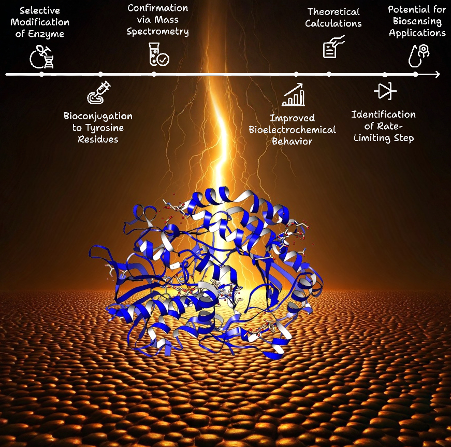13-Jun-2025
We all use smart devices containing billions of nanometre-sized transistors. However, as predicted by Moore's law, the exponential scaling of transistor size and processing power has significantly slowed. Manufacturing increasingly smaller transistors from inorganic semiconductor materials on chips is becoming prohibitively complex and expensive. Research is approaching the fundamental limits of lithography, the primary chip manufacturing technology.
This study from Vecelytė et al (2025) proposes a fundamentally new solution to the inorganic transistor technology challenge: harnessing nature's ability to produce transistors. Appropriately modified biomolecules can function as semiconductor materials. Crucially, biomolecules are inherently nanoscale, approximately 1 nanometre in size, making them smaller than current transistor dimensions. While existing literature often emphasises electron transport or tunnelling through biomolecules, this work highlights the critical role of hole transport (positive charge carriers) in biological structures.
The study comprehensively investigates the bioconjugated glucose oxidase enzyme for bioelectronic applications. The team selectively bioconjugated phenothiazine and phenoxazine redox-active groups to tyrosine residues on the enzyme surface using an electrochemical method.
Mass spectrometry was carried out at CEITEC, part of Instruct-CZ, utilising the sample preparation and High-Resolution Mass Spectrometry available at the facility. This confirmed success of the modification of tyrosine residues, specifically revealing the oxidation of phenothiazine to phenothiazine-5-oxide during this bioconjugation. The resulting bioconjugated enzyme exhibited significantly enhanced electrochemical properties, including increased anodic currents under anaerobic conditions and a wider operational potential window than the native enzyme.
Gintautas Bagdžiūnas, group leader, said: “During this research, we benefited from an invaluable collaboration with leading mass spectrometry experts from the Central European Institute of Technology and the National Centre for Biomolecular Research, Faculty of Science at Masaryk University, Brno, Czech Republic. Their state-of-the-art facilities and extensive knowledge were instrumental in enabling the precise mass spectrometry characterisation of our functionalised enzymes, a critical step for advancing our research.”
Theoretical computations supported the notion that the modified tyrosine residues facilitated the efficient transfer of holes between the enzyme and the electrode. Structural analysis indicated the preferential electrochemical bioconjugation at tyrosine residues, underscoring their importance for charge carrier injection from the electrode to the bioconjugate, which appears to be the rate-limiting step in the bioelectrocatalytic process. Notably, internal tryptophan residues within the enzyme remained crucial for hole hopping to the cofactor. Ultimately, the team successfully transformed the bioconjugated enzyme into a semiconductor while fully retaining its biocatalytic activity. Figure 1 indicates the workflow of the project.

Figure 1. Process of the study.
The study demonstrated that a modified enzyme functions as a semiconductor while fully retaining its biocatalytic activity. These findings underscore the significant potential of bioconjugated enzymes as promising candidates for single-molecule bioelectronics. Future research will optimise the bioconjugation process and explore novel redox-active groups to enhance performance and versatility further. This breakthrough will create chemically powered transistors and logic gates with chip densities potentially a thousand times greater than current inorganic technologies. Moreover, these bioelectronic components will be inherently biocompatible with living organisms. Future research is thus oriented towards pioneering future, as yet unforeseen, applications in this field.